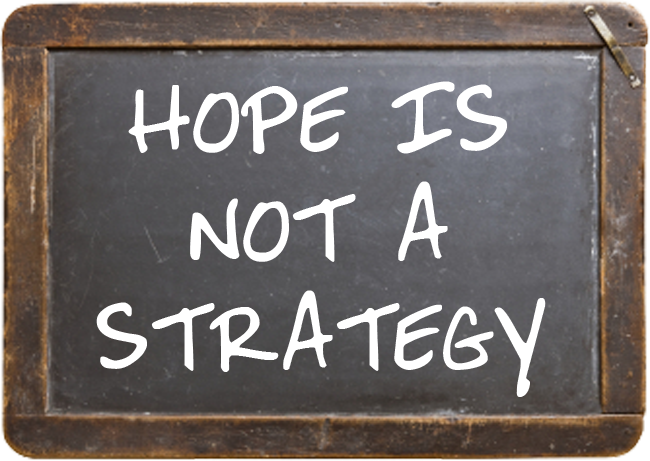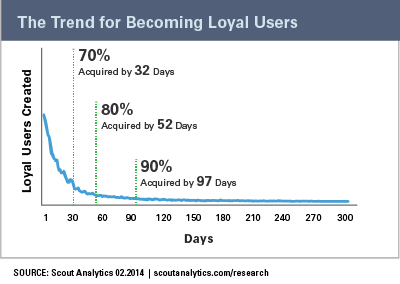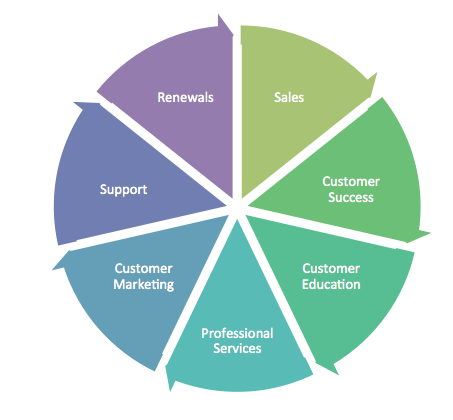Search Waypoint Resources
Hope is Not a Strategy for Onboarding Customers

I recently had lunch with my friend and colleague Roderick Jefferson. Roderick is a nationally recognized educational and motivational speaker and is also an acknowledged thought leader in the sales enablement space. When Roderick shared his tag line “Hope is Not a Strategy,” something clicked for me. Talking with Roderick validated trends I’m seeing with customer onboarding and enablement.
I too often see subscription software companies use sophisticated sales and marketing strategies to move prospects through the sales funnel, and then use hope as a strategy to enable customers. Companies carefully align the sales and marketing teams, demonstrate the impact of marketing campaigns through every stage of the sales funnel, and then celebrate winning new logos. Yet, an orchestrated post-sales customer journey is missing.
Companies hope customers know what to do after they buy their software. They hope sales reps sell and customers buy enabling services like Professional and Education Services. Companies hope their customers implement and adopt the product successfully, without needing much assistance, and then hope customers don’t log too many Support tickets. Finally, they hope customers renew.
Hope is not a strategy
At my previous company, we had great customer programs and services: excellent customer education offerings (which I launched), highly technical professional services consultants, sharp and responsive support agents, and caring and technical Customer Relationship Managers (CRMs).
However, without clear hand-offs from sales, an orchestrated onboarding process, or a defined account owner, hope was our strategy. We hoped customers would find their way to our services and be successful, although we never defined what success meant. When there were issues, we hoped someone internally would jump in and own the account. We hoped customers would renew when we contacted them 90 days before the subscription renewal.
Do you hope your customers are successful?
ServiceSource finds the first 90 days are critical to onboard and engage customers. They indicate “If your new users are not loyal within the first 90 days, there is less than a 10 percent chance they ever will be. Yet too many companies don’t adequately invest in customer onboarding and adoption to ensure satisfaction and minimize attrition rate.”
McKinsey also indicates that onboarding customers is the most important part of the customer journey. Using hope as a strategy does not create enabled customers who renew and buy more.
Building an Orchestrated Customer Journey.
We celebrate new logos, while CSMs put out fires. We cheer heroic efforts to rescue at-risk key accounts at renewal time, while the vast majority of our customers are not engaged in a meaningful and ongoing way. The cost to save accounts adds up to two to three times the customer license value. This is an exhausting and expensive approach, leading to both high customer and employee churn.
At my previous company, we faced serious trouble if we didn’t engage with customers in a scalable way. I saw the need for a more effective approach and reached out to internal teams and customers to learn more. What I found was a perception that every customer was unique. Because the product required technical and developer expertise to implement and customize, it seemed every implementation was special and required expensive technical resources. This kept us in reactive mode. Internal teams didn’t see a way to move beyond assigning technical resources to fix accounts in trouble, and customers insisted their teams were too smart and technical to need Customer Education or Professional Services.
I uncovered a scalable approach to enable customers. Rather than asking for more technical resources, customers wanted a personal touch. They preferred pro-active guidance, rather than reactive fixes. They repeatedly told me, “We need a quarterback to guide us through the implementation and adoption of your product.” They wanted best practices rather than “digging for information,” and “groping in the dark.” Our support team was great, they said, but customers were logging cases and support agents resolving them when they shouldn’t have been down that path in the first place.
ServiceSource indicates, “Without a successful customer onboarding program, most of your customers will never realize the value of your product or service. But if you carefully monitor and engage customers throughout rollout, you will be on the path to a more lucrative customer relationship.”
We pulled the customer enablement teams together to tackle customer onboarding. While we acknowledged that each customer had unique components to their implementations and usage of our product, we defined a common customer journey and onboarding process that all customers could leverage. This started with front-loading the relationship. We defined a new Customer Success Manager role to be the quarterback that customers requested, with a strategic business focus. We moved the technical Customer Relationship Managers (CRMs) to a new Customer Success Engineer role to do the deep dive technical work when needed, but not to own the customer relationship. With these new roles we next defined an onboarding process with clear handoffs from Sales to the CSM team, then from CSMs to Services, and with regular check-ins along the journey.
Our product was technical, so a quick implementation in the first 90 days was out of the question. Implementations could take as long as 12 months, with an extreme of 18 months, meaning we often didn’t find roadblocks until months after our product was sold. However, because those first 90 days are so critical, we defined a “blueprint for success” with key milestones and deliverables customers could reach within that time frame.
CSMs and CSEs worked closely with new customers to reach the milestones. This ensured customers were onboarded according to our best practices, were on track with their implementations, celebrated wins with their internal teams, and most importantly showed progress to their internal stakeholders on the impact of purchasing our product.
Our teams settled into this new framework quickly. It made sense to be proactive. It made sense to orchestrate the onboarding process rather than rely on hope. To further improve our new customer-centric approach, we bundled education and consulting services into the Customer Success package. We worked with the Marketing team to create an onboarding campaign to engage new customers for the first 12 months, tying together the milestones and services of the onboarding and customer journey.
As a result of this new orchestrated approach, we created a new Customer Success organization, and all post-sales customer-enabling teams moved under it, including Professional Services, Customer Education, Customer Success, and Support. This enabled our company to position ourselves as a solution rather than a technical product.
With clear methodologies and frameworks to engage customers, we set customers up for ongoing success and increased product usage in the critical first 90 days. One customer shared, “Having dedicated guidance cut down development time by at least 20%.” Customers had proactive and strategic guidance to move them along a clearly defined journey, and when an account did have issues, CSMs advocated for their accounts across the organization. The company moved from a reactive mode, using expensive technical resources to put out fires, to a scalable approach, and internal teams moved from crisis mode to breathing and sleeping more easily.
Are you using hope as a strategy?
It’s time to be as deliberate about customer onboarding, as sales are about their sales cycle. Define and build your post-sales customer funnel, with orchestrated customer onboarding programs and frameworks – and see how customers will fall in love with your business.
This article is a guest post from Donna Weber, the Customer Success lead with Kickstart Alliance, a B2B leadership and operational consulting team with deep expertise in scaling and optimizing software companies.
#customersuccess #customereducation #pulse2017
Photo by Warren Wong

